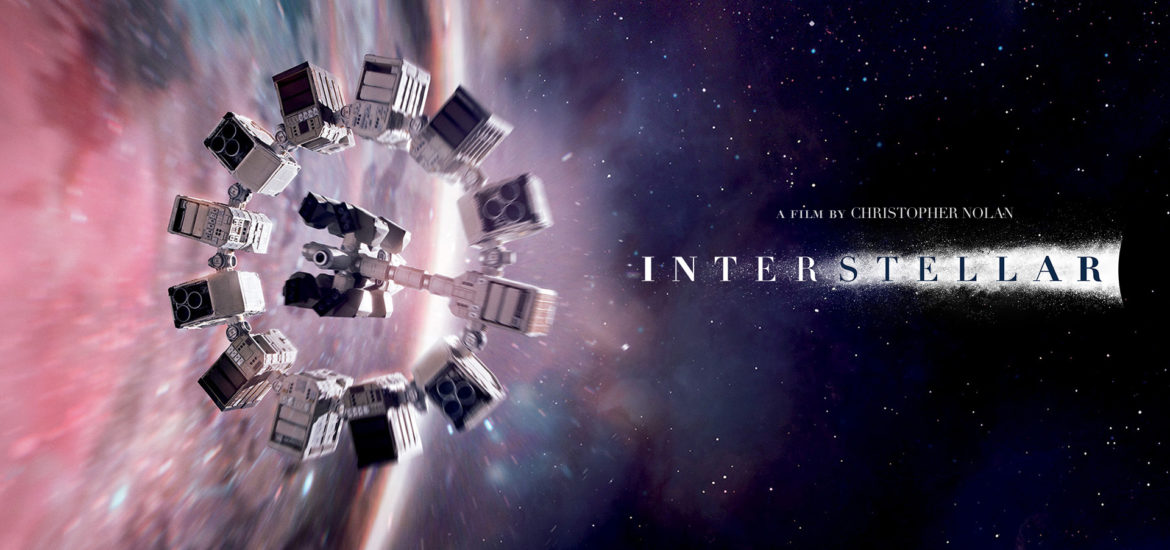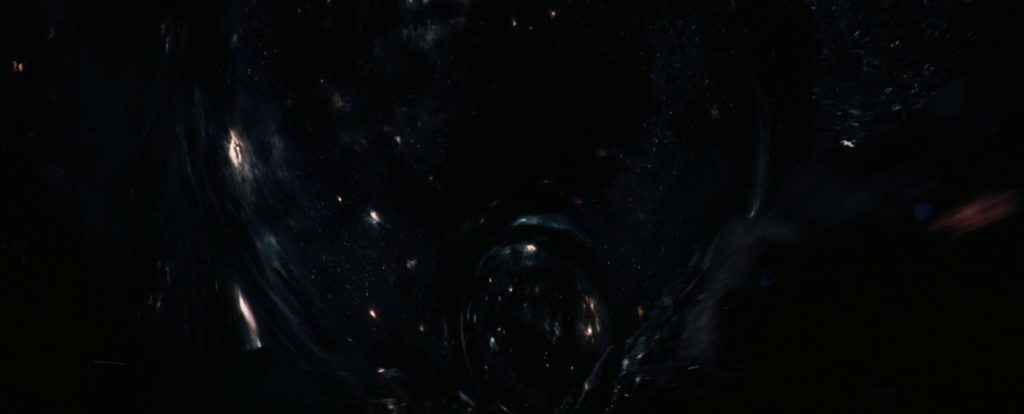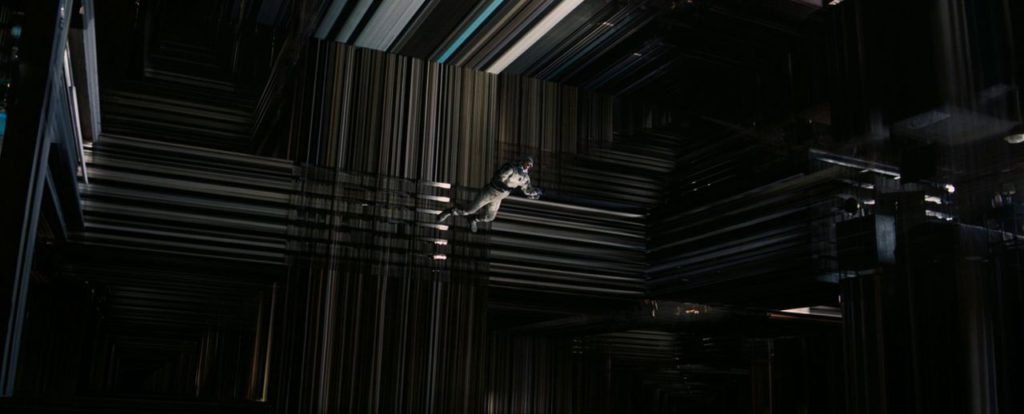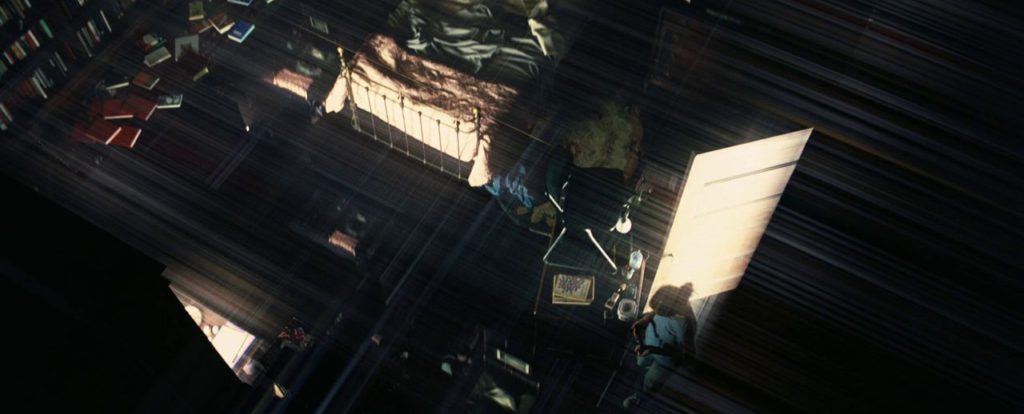Interstellar (2014)
Plot: Exploring New Dimensions
Interstellar was released in 2014 and directed by Christopher Nolan. The film is about a crew of astronauts that attempt to go through a wormhole to enter a foreign galaxy and find a new planet for humankind. In the second half of the 21st century, humankind is on the brink of going extinct. Earth opposes mankind and science is believed to be nonsense. However, the NASA still exists as a secret organisation and has sent twelve astronauts on a mission called “Lazarus project”. Cooper, the protagonist of the film and a former engineer, is one of the astronauts that is supposed to rescue the previous ones and see whether one of them has found a planet to settle on. He, Dr. Brand, a female scientist whose father has worked on the program for all his life, and others travel through a wormhole near Saturn that transports them into a new galaxy. They believe that the wormhole has been placed there by an alien species. As the centre of this new galaxy is a black hole and not a star like the sun, time elapses much slower. As a consequence, Cooper’s daughter Murph is an adult after the crew investigated the first planet, which they deem not suitable for human existence. She starts working on the equation that Dr. Brand’s father found in order to find a way to save humankind. Dr. Mann, one of the astronauts sent through the wormhole earlier, who supposedly found a suitable planet, where Cooper and his colleagues eventually arrive at, has lied and betrayed them in order to escape the planet on which no life is possible. After a series of unfortunate events, only Dr. Brand and Cooper are alive. While Dr. Brand travels to the one planet they have not investigated yet, Cooper tries to travel through the black hole. There he discovers that singularity does not crush him. Instead, he enters a fifth dimension and is able to communicate with his daughter through her bookshelf. The science behind this tesseract and how it influenced the images and production will be explained in the following chapter. Eventually Cooper explains to Murph through morse code that time and gravity are dimensions which can be controlled. He is later rescued and discovers that his daughter, now dying of old age, has found the solution to the mathematical problem and has built space stations on which humankind can survive until they travel to the planet Dr. Brand now lives on. In between, family issues are used to create further tension, but the overall structure of the plot reflects the development of humankind as depicted in the film and compresses it into three hours. Murph’s age also indicates this development. The first part of the film is set on earth, where Murph is a child and the audience believes that there is no hope for humanity. The second part is set in space. Murph is an adult and still tries to solve the problem her father and Dr. Brand’s father left her. At this time, humanity’s destiny is still uncertain. The final third takes place in the five dimensions. Murph is an old woman and humans live on a space station, where they await news on suitable planets.
Interstellar is not the first work to explore the possibility of alternate realities, parallel universes, and the implications something has that goes beyond our three-dimensional world as we know it. As Ruth Ronen comments, “the growing dominance of concepts such as possible worlds, accessibility among worlds, necessity and possibility, nonexistence, counterfactuality, cross-world identity and epistemic worlds, […] reflects epistemologically less restrained ways of thinking about philosophical problems” (19). This notion, however, is not restricted to philosophical problems as scientific evidence has been found throughout the years that makes parallel universes and the concept of space and time a real issue to deal with. Hence, Interstellar discusses the idea of possible worlds while including scientific research and facts, allowing for an entertaining yet informative way to discuss its topics. Science fiction in general is well known for exploring these topics, but Interstellar takes a relatively novel approach as the filmmakers asked physicists for assistance. The following chapter will elaborate on the ways in which physics influenced the production and iconography. The point being made here is that even Interstellar’s plot deals with new worlds.
“New worlds” is, of course, a loose term that can be applied to many spaces and places. In science fiction media it often refers to space, but the term can also mean everything that is beyond a frontier. The term “frontier” was coined by Frederick Turner, who claimed in 1893 that America is dependent on finding new frontiers to establish an American identity. As frontiers are crossed they disappear, hence new frontiers need to be found or defined. The first frontier in America distinguished settlers from Europeans and Native Americans alike, helping Americans to construct their own identity. Turner describes this as a process of civilization, assimilation and becoming American:
In spite of environment, and in spite of custom, each frontier did indeed furnish a new field of opportunity, a gate of escape from the bondage of the past; and freshness, and confidence, and scorn of older society, impatience of its restraints and its ideas, and indifference to its lessons, have accompanied the frontier. (Turner 38)
After the frontier reached the west coast, the moon was the next frontier, as some claim. And as there is an endless void to be explored, space as the next frontier seems to be the logical consequence. “There are always new frontiers of the unknown along the fringes of what we know. Even if we never escape our own solar system, we can always push the edge of knowledge farther and farther out” (Williamson 51). Vivian Sobchak, too, explains that science fiction is a vessel to explore the unknown beyond human perception. Pushing the frontier, seeking freedom and knowledge is a key element of Interstellar, and taking risks while using science is what makes humans indistinguishable and autonomous in the film. The dangerous environment depicted in Interstellar, primarily space, but also planets on which toxins pollute the air and gravity creates enormous tides, is an elementary part of the plot. Dr. Mann even betrays his colleagues in order to escape the harsh environment on his planet. The film hence acknowledges something Gary Westfahl stated science fiction films set in space would lack:
outer space is an environment radically different from all those that humans have previously explored. It is a realm without air, without water, and without material resources; a realm of zero gravity, extreme temperatures, and no protection from harmful radiation. A film about space travel, even if designed to entertain, should in some way acknowledge these harsh realities. (Westfahl 55)
Westfahl demands that more science fiction films should include scientific data and portray space as dangerous as it really is. Interstellar does exactly that and by foregrounding the search for a planet humans can live on, the film highlights the special circumstances that are needed for a human-friendly environment while demonstrating that space is a realm we yet have to understand. The wormhole signifies yet another frontier that humankind has to cross.
Interstellar reiterates the importance of science and the survival of the human species by virtue of space exploration. Besides, the film portrays two female characters, Murph and Dr. Brand, who eventually rescue humankind. Hence, female empowerment, women in science and men nurturing people by farming are topics that cannot be excluded in this analysis. The plot reacts to many programs that encourage women and girls to choose a career in natural science and depicts women as heroines instead of letting male characters rescue everyone by virtue of combat and weaponry. These are two major themes that show how Interstellar reacts to contemporary discourse, the attitude towards science and the depiction of female characters. Moreover, the film suggests that science is a requirement for humankind to survive. To overcome the decay of earth, scientists in Interstellar explore space and hope to find a new planet to live on. The ending shows that humans have evolved and gained access to multiple dimensions, influencing spacetime and investigating gravity. Therefore, the film reacts to contemporary concerns and offers a possible development of life on earth: One the one hand, Interstellar paints an eerie picture of our future that is caused by irresponsible behaviour, but on the other hand, the film excludes contemporary developments that are dominated by bigotry, war, and terrorism. Contrary to the dystopian world of Alien, Interstellar suggests solutions and scientific approaches to contemporary problems. The underlying motif of Interstellar is: How far can humankind go – metaphorically and physically. The film is a utopia and portrays an optimistic foreshadowing. As the filmmakers included scientific data, they also articulate this meaning on a meta level. The following chapter shows how this was achieved and how the cinematographic elements contribute to the film’s message and meaning.
Themes and Images: Going Beyond Human Boundaries
This chapter focuses on the implementation of scientific data and knowledge and how this affected the reception of the film as well as its production. “Recent scientific and technological breakthroughs demonstrate that the gap is being bridged between science fiction and science fact, between literary imagination and mind-boggling technoscientific realities” (Best & Kellner 103). Interstellar is a recent example for this development. It relies on actual scientific facts in order to create a futuristic, but realistic scenario that is based on contemporary theory. Kip Thorne, the physicist who assisted Christopher Nolan while directing Interstellar, wrote a book about the science that is mentioned in the film. He elaborates on the creation of the wormhole and the hypercube, the so-called tesseract (see Thorne 253). This chapter discusses two specific scenes in regard to the actual scientific data used to create cinematographic elements and specific images.
The previous chapter was about the wormhole as a frontier and the structure of the plot that exemplifies its overall theme: the future of humankind. The scene in which the crew travels through the wormhole offers further insights on an audiovisual level.
Fig. 5: Going through the wormhole. Interstellar. Directed by Christopher Nolan. Paramount Pictures, 2014: 00:58:03.
There are few colours and most of the scenery is black (see fig. 5). This implies the unknown sphere the characters are headed to, they do not know what awaits them. As they slowly approach the wormhole, a specific soundtrack is played. It is also used when Cooper travels through the black hole later and also every time the plot approaches an event that is associated with the advanced civilization: like travelling through the wormhole, which has been put there by said advanced humankind or exploring the tesseract, a construct by humankind that has evolved. Cooper and his colleagues briefly claim that they could see what awaits them. Thorne elucidates this circumstance: a wormhole that can be held open is a shortcut. When light travels through the wormhole, it brings a distorted picture of the other side (see Thorne 133). Although a wormhole that stays open is only an educated guess (see Thorne 132), its depiction in the film is as accurate as possible. For the actual trip, however, Nolan had to ignore Thorne’s calculations in favour of a “fresh and compelling” (Thorne 145) image – the journey would be too fast and thus less interesting to watch. The final scene shows a trip that lasts minutes and it still conveys a sense of fast travel as light passes the ship quickly. Furthermore, the various walls of the wormhole move in different directions, illustrating how a wormhole bends spacetime. Non-diegetic sound is completely omitted to not allow for anything that reminds the audience that they are in a movie theatre. When the camera shows space, there is no sound at all, just like there would be no sound when you are floating in space. When the camera returns to the interiour of the ship, one can hear the alarm system and the character’s noises – a further attempt to make the scene appear realistic while also differentiating between the old world, personified by the crew, and the new world, which this new galaxy will become. In addition to this, the differentiation marks the moment the film traverses from the first to the second part of the plot.
For the second scene that I chose to analyse, the film did not rely on special effects only and built the complete set instead. Again, the filmmakers focused on scientific proof to construct something that would demonstrate the abstract concept of five dimensions. As fairly advanced knowledge of physics is required to fully grasp this concept of five dimensions, Nolan did not expect viewers to understand it, but “feel a logic behind it” (Goldberg & Hillhouse 1:47:38). The so called tesseract, in which the majority of the third and last part of the film takes place, is a four-dimensional space. The director wanted to understand the mathematical logic behind it in order to construct a set that is believable. It is endlessly reproduced space. The tesseract was created based on a computer model and reproduced in reality so that the actors themselves were able to understand the abstract concept the film attempts to make visible. In the film, Cooper is outside of space and time, but is able to send messages that his daughter would get at a certain place and time. Her bookshelf acts as his voice. In this tesseract, gravity is used to send messages, a watch that Cooper gave his daughter before his departure is instrumentalized (see fig. 6). In a documentary about the film, Paul Franklin, VFX supervisor of Interstellar quotes Einstein and explains that gravity is a wave that propagates through spacetime (Goldberg & Hillhouse 1:48:53), which is why Cooper can use it to send messages to his daughter.
Fig. 6: The Bookshelf in five dimensions. Interstellar. Directed by Christopher Nolan. Paramount Pictures, 2014: 2:22:44.
Soon, Murph discovers said messages. This epiphanic moment is reinforced in the scene’s music. An organ plays, an instrument that is majestic due to its size and its associations: it suggests greatness and power and is often used in religious contexts. The sound is non-diegetic, which stresses the omnipresence of gravity and how it is detached from time, but also mirrors the importance, tension and urgency of the discovery. The music evokes a feeling that there is something great happening that will influence humanity’s future. The meaning of time and the temporals suspense is also incorporated in the music. Time is the enemy, not only because Murph’s brother is about to find her and impede her investigations, but also a sandstorm is approaching, forcing the inhabitants to leave the town. The music reflects this and plays a ticking sound. Furthermore, the morse code Cooper sends is part of the sound and reflects the plot on a subtle level (Golding 4:26).
Fig. 7: Murph discovers the secret in the watch. Interstellar. Directed by Christopher Nolan. Paramount Pictures, 2014: 02:30:43.
The camera alternates between Cooper and Murph, his and her view, highlighting their connection and the idea that love, just like gravity, can travel through spacetime and affect reality. The associative camera creates the illusion that both events, him being able to communicate through five dimensions and Murph being in her former bedroom receiving the code, take place at the same time. The composition of the scene adds to that impression. The characters are on opposing sides, but Murph is also everywhere as her room is endlessly reproduced and can the past, present and future can be seen in the tesseract.. The composition emphasizes the idea that gravity can surpass spacetime and subsequently offers a perspective from varying points in this scenario. The colours are mostly brown tones, representing sand that is omnipresent (see fig. 7). The earthly colours remember viewers that the bedroom is on earth. There are also some blue details, representing the sky and the ocean. To conclude, the cinematic elements in this particular scene add new layers to the meaning and support the plot, even expanding its meaning and offering additional information, emphasizing the greatness of Murph’s discovery and making the concept of five dimensions visible.
As already mentioned in the previous chapter, Interstellar deals with the importance of scientific progress. The plot already points towards this idea, but the cinematographic elements make it very clear that the filmmakers advocate research – just like the filmmakers included theories and physical data. Humankind needs to think as a species at the expanse of individualism and strive for more than making everyday life more comfortable. We are supposed to focus on scientific progress, push boundaries and take risks, not rely on an alien form to contact earth, but take the first step and venture into the unknown realms. The scenes that were analysed show that everything, from the camera perspective to light, colours, music, and plot imply meaning, supporting each other and providing further hints. Regarding this approach in filmmaking in addition to the plot mentioned earlier, Interstellar, too, comments on contemporary discourse and offers alternatives and insights into possible scenarios.



